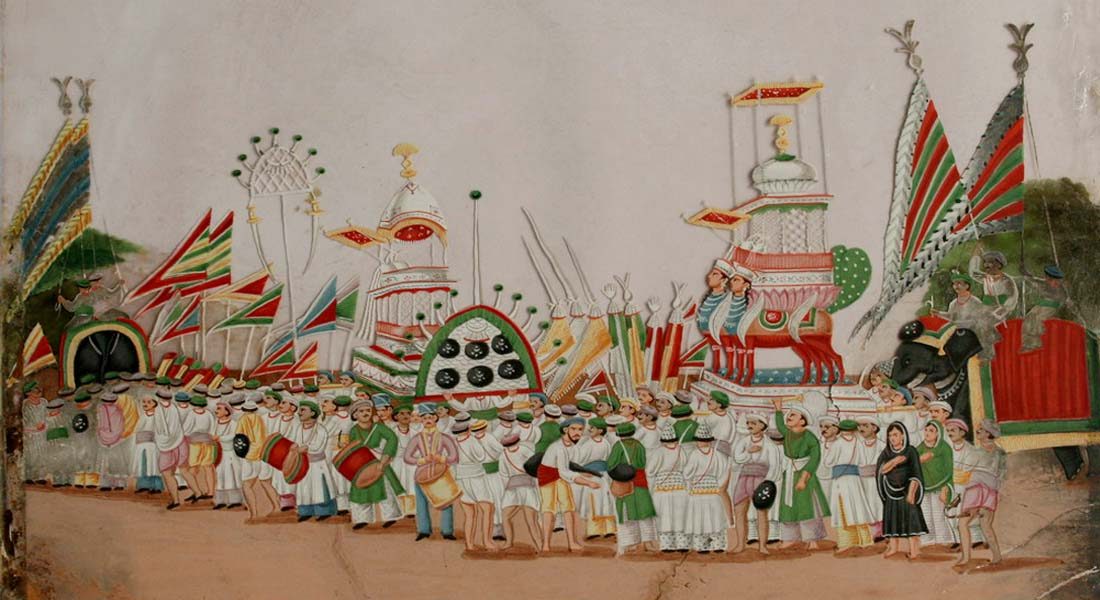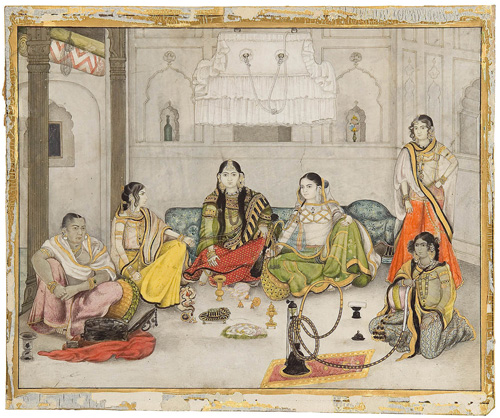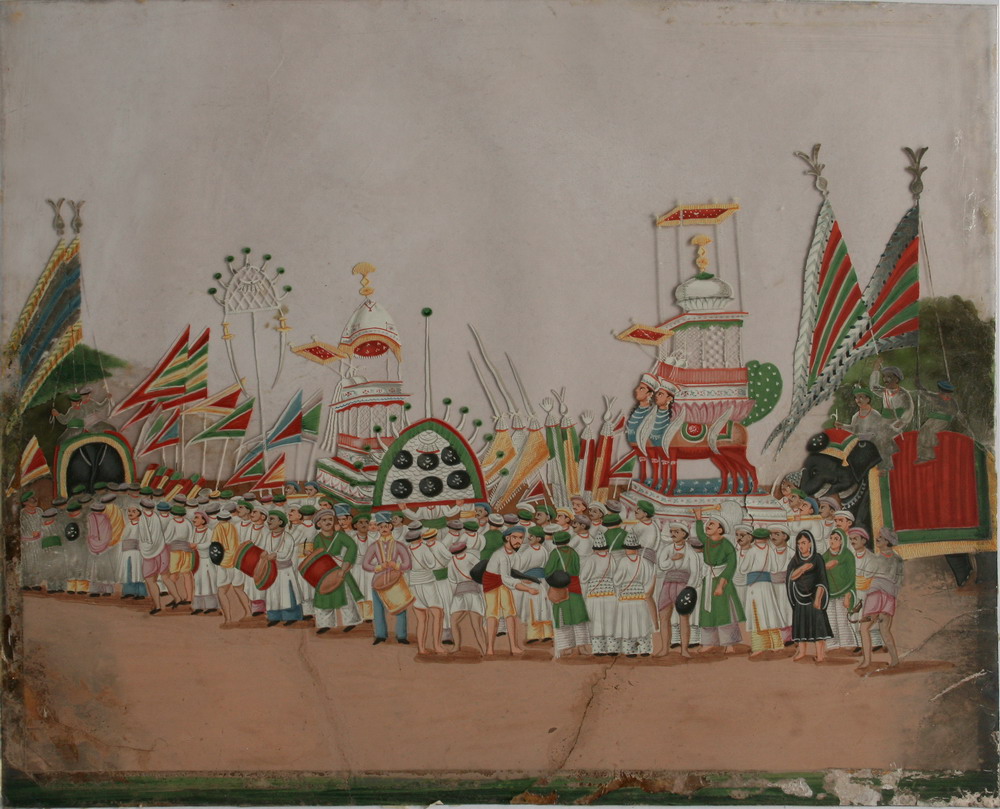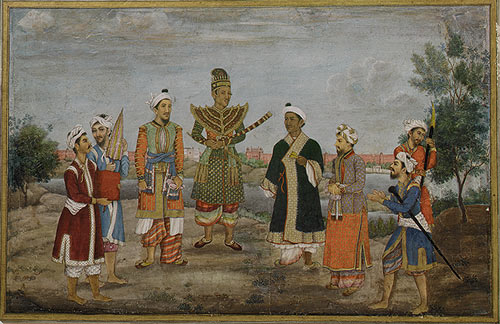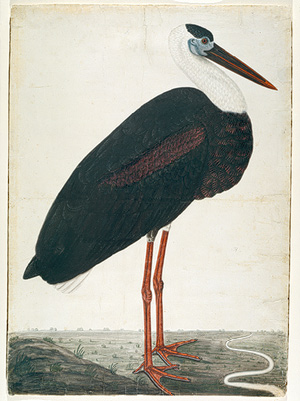
Dr. Abid Hadi, Associate Professor, Aligarh Muslim University, Aligarh, Uttar Pradesh
—
Patna Kalam : Its Glory and Saga | The way of executing a work of art or custom of expression or capability of expression is Kalam or Style. The depiction of the characteristics features of distinguished people or a particular span or space of time could be termed as Kalam or Style. The style could be based on geographical conditions also. To some extent, the Kalam or Style could be accepted as a regional language also for it represents the distinguishing features of its region through paintings in an exclusive way. This regional language also draws a dividing line between two languages spoken in two different regions. In our social environment, it has the credit of language also and one who knows or has mastery in style can be considered a genius par excellence. Thus, to spread your subject knowledge, feelings, emotions, thoughts ideas, etc. in a particular region through the medium of the brush is called Kalam or Style.
Delhi Kalam is established as a supreme and classical art form of Mughal artistry. Patna kalam like Delhi kalam is also an art form based on artistic techniques. This kalam was established by the painters of old Delhi. Later on, regional artists were influenced by them and followed their footprints. This style got encouragement by the artists of the Mughal emperor Shahjahan and Aurangzeb and had also worked in the court of Mohammad Shah. These artists had to work under the Indian patronage after the end of the Mughal Empire for their livelihood. At the downfall of the Indian patrons in 1730, these Mughal artists started to migrate Murshidabad except that, it was an important center of Indian business. Another reason could be their exploitation by the other regional artists as these people were not familiar with the place. So Murshidabad could have been the best place as there was no court style (Durbari style) of its over and Murshidabad was establishing itself as the center of business practices of eastern India and expanded itself to Qasimbazar, the mainstream of Indian business spreading its branches on Hoogly, dealing with European countries, becoming rich and sonorous. Thus, Murshidabad a profitable business hub and attracted painters across India and established itself as a famous school of painting.
The migrated artist started living in Baluchak village of Murshidabad district situated at the bank Bhagirathi river, got the patronage of Shia Nawabs, but their court connections do not seem to have been more than temporary and occasional. They were employed to decorate the mansion walls of the court through their paintings. They were also made to do paintings on mica as is evident in paintings of procession of Moharram. These artists also made portrait paintings of Indian patron as well as European citizens living in India.
Murshidabad made the ancestor of Patna style artist available assured income and fulfilled all their requirements but 1750, once again, the time changed and some artists had to migrate between 1750 to 1760. The reason being the downfall of Murshidabad or the rulers’ insolvency. The afghans and Marathas plundered and looted Murshidabad. They also robed the ships that embarked on merchandise from Hoogly river. These were a struggle for existence between the Nawabs and East India company, that resulted in the downfall of Murshidabad.
Between 1750 to 1760, these artists once again migrated to Patna. In the beginning, only a few migrated to Patna with their family, but when they found Patna profitable, the others also followed them and this continued till the primitive years of the nineteenth century. Finally, all of them settled in Patna. The reason for their migration to Patna is not known for the plight of Patna was no better than Murshidabad between 1750 to 1793. The social and political condition of Patna was unsafe and it was also suffering from the rift of Nawabs and the company. After all, it was a major city of India of great importance after Murshidabad and Calcutta. Patna situated at the bank of Ganga river, had been a commercial but since time immemorial. It exported different goods like sugar, saltpeter for gun powder, indigo, musk from Bhutan, lac, cotton, etc. during the establishment of the British factory from 1650 to 1657. The city was progress for the occidental society. The patrons of these artists were anonymous and their names had not been preserved. The migrations of artists were only from one bazaar to another.
The glimpse of the European colony in the advent of the 17th century proves that there was no favorable environment for the artists to settle, but at the end of the 18th century, Patna established itself as the center of the new administration. The very administrative changes which weakening Murshidabad were strengthening Patna. There were also adventures, merchants, and planters, while a number of rich Indian landowners of a large estate and ancient lineage were residing in the suburbs. It was from that time onwards that the Patna kalam painters came into the existence and we must now consider the circumstances which led to the expansion of the school.
During this period, the European abstained from Indian relationship but admired Indian art, Indian landscape, and Indian culture. They appreciated the paintings of Indian artists and presented them to their relatives abroad. The European people used to keep a distance from Indian society and Indian culture in the 18th century but were in touch with their paintings. In spite, however, of this lack of social intercourse, many Europeans in India were interested in the Indian landscape and the Indian social scene. The Patna painters gradually expanded the market and fulfilled its requirements. Patna appeared to be a better option for Murshidabad. Gradually Patna Kalam became an essential and profitable part of Patna artistry and existed till 1830. These artists used to paint ‘sets of caste occupation’ known ‘Firka’. The contents of firka were based on common everyday life like- washerman, butler returning from the market, tailor, sweeper, and slave struggling with dog, etc.
Patna painters depicted hawkers, bangle sellers, butchers, fish sellers, carpenters, washerman, baskets sellers, distillers, etc, in their paintings. They also depicted rural and urban lifestyles in their paintings. Patna painters may have been consciously adapting their style to that of a European who greatly respected for his versatility and competence. Patna painters were exploring the European market and trying to adapt their style to European fashions. While this demand for “snapshots” and scenes of ordinary life was being established, a second and further demand based on a second type of European taste had also developed. If certain European were interested in documenting Indian life, others valued a pictorial record of their own families and throughout the eighteenth and nineteenth centuries miniature portraits on paper, vellum, bone, and later, ivory, was the fashion with the upper and middle classes.
The painters of Patna kalam, first of all, came to Patna in between 1750 to 1760 and settled in lodikatra, chowk, dewan mohalla, and macharhatta mohallas. But the evidence of their coming to Patna and other authentic documents about them is not available. We simply know that they had come to Patna and established themselves as on painters of Kalam here. Neither the picture nor the name of any artist of this kalam as proof or evidence is available. This is proving that the officials of East India Company carried everything to England and Europe along with them. In the London Museum, even today, the Patna Kalam gallery exhibit such many pictures and works of art, which require research.
In the year 1770, this style was properly established. Since then for the ensuing forty years, a lot of pictures are preserved. In the history of Patna Kalam, the first artist who became popular was Ram Sewak Ram (1770-1830). Before this, he was working in Murshidabad. In the collection of Ishwari Prasad, Ram Sewak’s twelve pictures were available. He got it from his grandfather Shivlal, who was also a painter of Patna Kalam. In those days, the custom of putting a signature on the painting was not vague, so the signature of Ram Sewak is not available. On the demand of European people, all these paintings were based on Indian life. The way he used to paint his picture is known as Kajli Sayahi. The pictures were painted directly by brush. Pencils were not used during those periods.
There are so many other artists also who are working in Patna, whose paintings are available. In the year 1800 Hulas Lal (1785-1875) joined the family of Lodikatra. He has come from Benaras. He was the cousin of Patna Kalam artist Jairam Das. Hulas Lal ancestors had come to Beraras from joint provinces and were working under the patronage of different kings. Shyam Bihari Lal, the grandson of Hulas Lal has acquired more popularity. The style of Hulas Lal was parallel to Ram Sewak.
A new growth of artist was in vogue apart from Hulas Lal and Sewak Ram. These painters initiated the Firka style set. On the other hand, the Firka set was in vogue, Nisar Mehdi, a Patna style artist who migrated from Murshidabad and settled in Lodikatra, earned more popularity in portrait paintings and Landscapes. His father settled in Lodokatra, Patna city after the downfall of the Mughal Empire. His ancestors had come from Iran and working as a painter in Mughal courts. Since the very beginning, Nisar Mehdi was an independent artist and his favorite subjects were portraits. Due to European influence on his artistry, the English officials used to send his paintings to their relatives as a gift. Apart from this, small pictured by him are preserved in different houses of different people and nawabs of Patna city. Apart from Nisar Mehdi, Mir Abbas Ali was also working for Patna Kalam, who died at the ripe old age of 95 in 1903. The picture is in the possession of Mr. Hassan Ahmad Khan, Rais, and Zamindar of Islampur in the district of Patna, not very far from the Patna city. The Artist Mir Abbas Ali was a retained artist, an employee of Mr. Hassan Ahmad Khan’s grandfather, Chaudhury Zahurul Haq of Islampur. Mir Abbas Ali had come from Lucknow and had been enjoyed a respectable career until the above-mentioned time period.
One of the paintings of Nisar Mehdi is preserved in Patna Art College of Nawab of Patna city “Nawab Meer Gadhiya”. Mohammad Hadi, Nisar Mehdi’s elder son acquired more popularity. When Mohammad Hadi was progressing in the field of artistry, Patna Kalam was at its downfall. But he started modern oil paintings along with miniatures paintings.
All these surviving pictures portray scenes of Indian life such as the European public required. They have a formalized precision and are characterized by the pointed noses, the heavy eyebrows, the deep-set staring eyes of their subjects and their haggard faces. In certain pictures, the forms are a means to a geometric pattern, and the picture is built up as a succession of angular relations. The figure is usually in deep sepia and a somber red ochre, while the clothes are dull white with soft grey shadows enlivened by pools of deep crimson and sometimes touched with dull gold and deep peacock blue.
We can divide the picture of Patna Kalam into three categories. First from 1830-1850, second from 1850-1880 and third from 1880-1945.
In the first category from 1830-1850, the market was expanded, five artists were popular and at the peak Jhumak Lal, Nityanand Lal, Fakir Chand, and Tunni Lal. We have a few pictures available apart from these painters, who made those paintings is still unknown. But one thing which is clear is that there were other active artists also. The pictures made by Tunni Lal and Fakir Chand are not available these days. We can just imagine that their market was Europe and all his paintings had been exported. Out of the few paintings which survive we may, however, distinguish three groups, a set of five scenes of Indian life by Hulas Lal. These pictures were inherited by Shyam Bihari Lal through his father, Bani Lal, and consist of Men Gambling at Diwali, a Men’s Music, and Drinking Party, a Holy Scene, together with a sketch for a different version, and Women Carousing at Diwali. In Men Gambling a background of soft yellow fawn is relieved by Chinese white instead of gold work on the mirrors, the Dacca muslin shirts, and chandeliers, while brilliant touches of soft purple and bright blue light up the lamps, chandeliers and men’s hats. The Men’s Music and Drinking Party has a similar fawn color and is enlivened by the brilliant green of the doors. The Holy scene with its swirling lines and the sketch for another version are in subtle shades of crimson. The Diwali scene glows with blue, green, yellow, plum, and crimson, and a far brighter than the other pictures. In these later paintings, a fluid curving line links form to form and Hulas Lal uses his naturalistic figures as the material for organic rhythm. A number of miniature portraits, these include portraits on ivory of European men and women, some of which are said to be by Jairam Das, while a few are studies for Indian patrons. These latter are mostly of conventional female types known as Begum Bahu. A few early firka paintings, these have the heavy eyebrows, sunken eyes and somber colors which derive from Sewak Ram, while a portrait of great-grandfather of Rai Sahib Balgovind Malaviya, with its blue stripped dari and sepia figures, although not itself a fikra painting, has all the essentials of the fikra style.
In between the second period 1850 to 1880, Fakir Chand Lal noted Patna kalam painter died in 1865, and it is unlikely that after 1850 either he or Tuni Lal produced many paintings. Their families, however, remained, and from 1850 to 1880 Patna painting is dominated by the two sons- Shiva Lal (c.1817-c.1887), the son of Fakir Chand and Shiva Dayal Lal (c. 1820-c.1880) the Son of Tuni Lal. During this period the European market reaches its peak and the patronage of Indian gentlemen also becomes of greater importance. The work of Shiva Lal falls into three distinct groups, firstly as a painter of miniature portraits he built up a large clientele of European as well as Indian customers, and at the height of his career was making appointments much as a portrait photographer makes them today. By the end of his life, he was painting similar miniatures for Indian families and also doing portraits of Indian ladies from life. But besides miniature painting, Shiva Lal also painted scenes of contemporary life for private patrons, and in this respect, his wide contacts were of great importance.
Shiva Lal was also widely known in Patna City, and one of his most important paintings, the Muslim Wedding scene, was commissioned by a Patna gentleman. In addition to organizing the production on business lines, he also knew how to sell the paintings. Some of the firka sets were painted by Shiva Lal himself, and it is significant to note how his style echoed his three activities. His miniature portraits are marked by a delicate realism, a minute fidelity which borders on the photographic. His larger scenes of contemporary life have a careful precision, a balanced location of forms. The Muslim wedding is not a random collection of lifelike midgets, but an assembly of figures organized in a single rhythmical scheme. There were a limited number of firka subjects which were reproduced over and over again. Many subjects used by the artists of the earlier periods were repeated. In between 1850 to 1860 there is not very much clear pictures about how many painters are working but only increasingly clear the names of six painters are known- Gopal Lal (1840-1911), with his elder brother Gursahay Lal (1835-1915), Bani Lal (1850-1901), and his cousin Bahadur Lal (1850-1933), Kanhai Lal (1856-1916), and Jaigovind Lal (1878-1908). Other artists probably drifted through the shop from time to time, and women-folk of the family also assisted. Shiva Lal’s sister Daksho Buddhi and his daughter, Sona Kumari (the mother of Ishwari Prasad) both are painted. Their paintings were almost always puja pieces for domestic use at festivals, but sometimes they helped with fikra sets, the red border on certain pictures denoting that they were done
by women.
Most of these painters were trained in Shiva Lal’s studio and began their careers as apprentices by making brushes from goat, squirrel, hog, and buffalo bristles, and preparing the various pigments. In the early days the painters had made their own paper from rags or had used handmade paper from Nepal, but by Shiva Lal’s time ordinary European machine-made paper was being used. Gradually the apprentices learned to paint, not in Mughal way, but in the European way, drawing straight on the paper in pencil, then colouring the picture and finally outlining or shading in a darker color.
The main characteristics of this collective style are the brilliance and definition of its color combination. There is very little shading, only faint modeling with stripling, and little blending of color. The composition of brilliant colors and their relation one to another. In the best miniatures, the areas of color are bounded by a vigorous line that springs the moves across the picture. A Mughal picture is, in essence, a pattern of colored shapes and lines. European painting in the eighteenth and nineteenth centuries was completely different. The Patna painters to the very end retained certain Mughal characteristics and adhered to the miniature tradition. They continued to paint flowers and birds, portraits and scenes such as weddings and processions. Novelties like the picture on mica were a relic of Murshidabad days.
Patna painting’s delicacy of the line is still important. Some of the best pictures retain much of the little grace of a Mughal portrait, moreover, certain pictures the line is used as in Mughal painting to circumscribe regions of color and link them in a single organic pattern. Some have the decorative quality of a Mughal painting, and the Mansur paintings of red flowers the Turkey cock, the Saras or Manohar’s Black Buck or Dara Shikoh album jonquil, if deprived of their elaborate borders, are merely more complex cousins of Patna paintings. Although the Patna painters often made use of a scientific perspective, they only use it when it contributes to the geometric pattern of the picture. At other times they distort as they like to satisfy the picture’s design. Moreover, in Patna paintings, the volumes are often sharply stressed, and every object in true Mughal style is precisely placed to form a pattern and yet at the same time to suggest three dimensions.
The European influences were often diametrically opposed to the Mughal influence, and the Patna painters only accepted that part of European art which could be reconciled with his predilections. The new contact led to an extension of the subject matter. The painters now look to painting portraits, even of women, from life. Since the technique of painting on ivory could easily be learned by them, the Patna painters could complete with European artists and mimic a European miniature so cleverly that the two can scarcely be distinguished. The color scheme was fundamentally changed; the glowing of Mughal colors gave place to the fashionable somber hues of the print when the pictures were intended for a European market. Another development was in the shading of solid forms. In the early pictures, the old Mughal technique of showing shadow by minute stripling or darker tones of the same color is given up, and shadow is shown with soft washes of color, as in an English water-color. The upshot of this fusion of two influences was a school of painting which, although in no sense major or of great aesthetic importance, is none the less authentic and distinct. The great majority of the paintings were essentially the work of a ‘bazaar’ school, and in the process of popularization, much of the early Mughal finesse and complexity were lost. If Patna paintings have sometimes a flowing line and brilliance of color, they are usually wanting in the subtlety and richness of the best Mughal work. Patna paintings also give a sense of dignity of labor, its mechanical serenity. Their grave precise images and solemn figures convey something of the poetry and pathos of a century. Patna Kalam was the world’s first independent school of painting which dealt exclusively with the commoner and his lifestyle also helped to gain popularity.
Consequently, the influence of two different styles produced one unique style in the form of Patna Kalam or PATNA STYLE incorporating great aesthetic beauty and exuberant consciousness. An excessive number of pictures were required in the works of Bazaar Style and the advancement of the excessive popularity of the Mughals deteriorated in this skill. There was a time when Patna Kalam was filled with flow of line and brightness of color, being the high demand of aristocratic families for its finery. On the other hand, the artists of Patna Kalam adopted the qualities of European pictures. A geometrical influence is visible in the pictures of contemporary lives. Indeed, it’s a wonder to see the paintings of painters of Patna kalam that they broke the age-old shackles of medieval conservatism for the sake of paintings of the Mughal age. On the one hand, there were the paintings of high-profile elite class life like- hunting, wars, music, raga, evergreen landscapes and on the other hand in Patna, these artists started painting the common everyday life. In the Mughal paintings, they were free to soar high with imagination but in Patna Kalam, they were restricted to the commercialization of arts. But, whenever they got an opportunity to paint the hidden imagination in their unconscious mind in the patronage of aristocratic people, they became visible in their paintings.
The Patna Kalam paintings were based on market and value. Hence, the subject matters were given great importance. The excessive use of imaginative subject matters like landscapes, backgrounds, etc., were being very expensive. To conclude, these backgrounds and landscapes which were the soul of Mughal paintings, vanished in the paintings of Patna Kalam. Patna Kalam during its downfall gave a new dimension to the future Indian art i.e. freelance painting. Paintings got freedom and liberty and as a result freelance paintings were imbibed with the feeling of nationality and played a vital role in the construction of a powerful nation. Even today, Patna Kalam holds a respectable position in the international world and is viewed with high esteem.
Note: This paper published in Art Family: International Art Journal for Arts and Aesthetics Vol-III
—
References:
1. Patna Painting by Mildred Archer-Published by Royal India Society-1948
2. Indian Painting under the Mughals by Percy Brown, Published at Oxford Press-1924
3. Indian Sculpture and Painting by E.B. Havell, published by J. Murray London-1908
4. Bharat ki Chitrakal by Rai Krishna Das
5. History of Murshidabad by J.H. Tullwash, London-1902
6. Oriental Drawings by Charles Gold, Published by Bunney & co, London-1806
7. The Patna School of Painting-Journal of the Bihar Research Society, Vol.xxxix by P.C. Manuk, pp.143-169-1943
8. Patna ki Kala evam Asthapatya by Dr. Abid Hadi, Published by Novelty & Co., Patna-2003
9. Different article references from newspapers, journals, souvenir and websites.
Other links:
Disclaimer:
The opinions expressed within this article or in any link are the personal opinions of the author. The facts and opinions appearing in the article do not reflect the views of Folkartopedia and Folkartopedia does not assume any responsibility or liability for the same.
Folkartopedia welcomes your support, suggestions and feedback.
If you find any factual mistake, please report to us with a genuine correction. Thank you.

